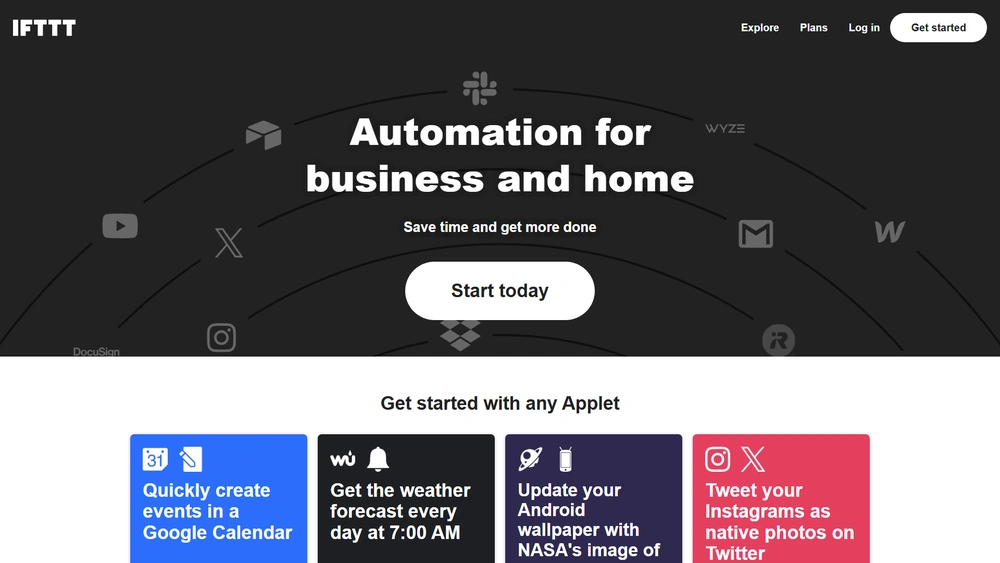IFTTT Overview & 2025 Industry Position
IFTTT (If This Then That) has long stood at the intersection of automation and accessibility, offering consumers and businesses a streamlined solution to connect services, apps, and smart devices effortlessly. As of 2025, its role in the rapidly expanding automation-as-a-service (AaaS) market is more vital than ever. With users demanding fewer manual steps and instant synchronization across platforms, IFTTT has carved itself a place as a must-have integration layer — both as a personal productivity booster and a lightweight business utility. Its 2025 positioning leverages low-code AI enhancements, deeper SaaS integrations, and a vastly improved UX for both new and experienced users.
From Launch to 2025: IFTTT’s Journey
Founded in 2010 by Linden Tibbets and Jesse Tane, IFTTT launched as a platform dedicated to automating digital actions using simple conditional statements. In 2013, the platform expanded to iOS integration and introduced its “Channels” concept. In 2014, it brought Android automation into play. Key pivots occurred in 2017, when IFTTT shifted from its free model toward paid Pro offerings and user-created applets.
Major milestones included:
- 2010: Founded with initial web-based triggers.
- 2013: iOS integration and mobile trigger introductions.
- 2017: Launch of IFTTT Pro with advanced applets and multistep logic.
- 2020: Deeper smart home integrations and business tier rollout.
- 2023: AI integration and 1,000+ services milestone.
- 2025: Adaptive automation (AI-assisted flows) launches.
2025 strategy thesis: IFTTT is poised to become the default orchestration layer across home, business, and AI-connected environments.

IFTTT Key Features
IFTTT’s core strength lies in its ability to create automated connections (applets) between over 1,000 digital services and devices. These features make IFTTT highly relevant for individuals and businesses alike in 2025:
- Applets: Drag-and-drop automation recipes linking triggers and actions.
- Pro Tools: Multistep logic, conditional filtering, and real-time execution.
- AI Assist: Automatically suggests personalized automation flows.
- Custom Integrations: Build your own services with simple webhooks or API access.
- Smart Home Power: Deep compatibility with Alexa, Google Home, SmartThings, and more.
- Workplace Connectivity: Ties business tools like Slack, Trello, Microsoft Teams, and CRMs.
Pro Tip: Use IFTTT’s AI-powered suggestions to uncover applets you didn’t know you needed — especially helpful when automating work tools or home routines.
Workflow & UX Enhancements
IFTTT’s 2025 user experience is sleek, mobile-first, and AI-enabled. Both the mobile app and web portal provide intuitive tabs for Discover, Create, and Activity tracking. The AI assistant presents real-time suggestions while building flows. New drag-and-drop logic blocks make building complex applets approachable even for non-technical users.
Workflow enhancements introduced in 2025 include:
- Applet debugging visualization
- Contextual search with synonym support
- Instant triggers for supported services
IFTTT Pricing Analysis & Value Metrics
| Plan | Monthly Price | Key Features |
|---|---|---|
| Free | $0/mo | 5 applets, basic services, limited support |
| Pro | $3.99/mo | Limits removed, multistep logic, filter/code blocks |
| Pro+ | $9.99/mo | Priority support, developer tools, 100+ service integrations |
| Team | From $19.99/mo | Branded connections, deployment tools, usage dashboards |
Value Summary: IFTTT Free works for personal use, but Pro+ offers the best value for power users automating across both work and smart home systems.
Competitive Landscape in 2025
| Platform | Strengths | Ideal For |
|---|---|---|
| Zapier | Advanced workflows, multi-service triggers | Startups, SaaS integrations |
| Make (Integromat) | Visual editor, complex flows | Technical users, automation-heavy ops |
| IFTTT Pro | Simple UX, great personal+smart home use | Consumers, freelancers, hybrid users |
Use Cases That Shine
IFTTT excels in cross-platform use cases, particularly where fragmentation across devices and SaaS platforms creates friction. Common workflows include:
- Syncing Google Calendar to smart home devices
- Automated backup of social media posts to cloud storage
- Connecting IoT sensors to messaging services for alerts
- Triggering Trello cards or reminders based on location or events
IFTTT Integrations & Ecosystem
IFTTT connects to over 1,000 services. In 2025, key integrations include:
- Smart Home: Nest, Hue, Roomba, SmartThings, Ring
- Productivity Tools: Asana, Notion, Evernote, Microsoft 365
- Communication: Slack, Discord, Telegram, Gmail
- Business/E-commerce: Shopify, Salesforce, HubSpot, Stripe
- AI & ML API Hooks: OpenAI, Azure Cognitive Services
Pros & Cons
- Pros: Easy to use, low-cost entry, wide device/app support, scalable
- Cons: Limited customization vs competitors, some features locked behind higher tiers
Final Thoughts for 2025
IFTTT remains a leader in automation for both home users and light-business scenarios in 2025, especially with its AI-powered creation tools and unmatched device compatibility. Ideal for freelancers, productivity seekers, and SMBs that want automation without a development team.
IFTTT FAQ
Yes, IFTTT offers a Free plan with 5 applets and basic integrations. For advanced features, Pro and Pro+ plans are available.
IFTTT Pro unlocks multistep applets, conditional logic, faster execution, and extensive support, ideal for workflows across multiple devices or services.
Yes, IFTTT integrates tightly with both Alexa and Google Home, allowing for voice-controlled and trigger-based automations.
IFTTT uses OAUTH-based authentication and encrypted connections. However, users should review permissions carefully when connecting third-party services.
Yes, IFTTT’s Pro+ and Team plans support business workflows, admin controls, and integrations with CRMs, cloud platforms, and analytics tools.